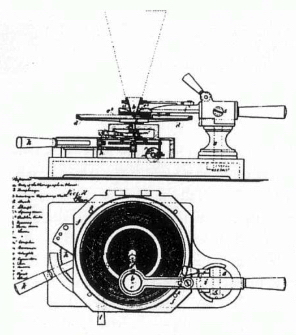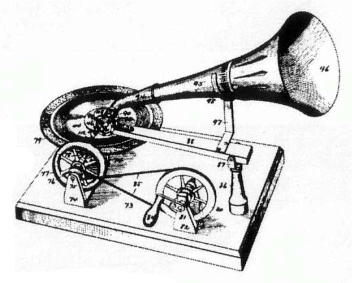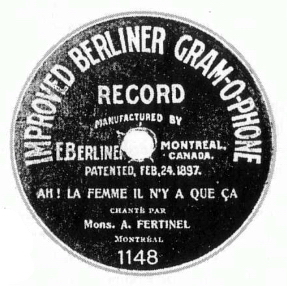|
A Short History of the First 100 Years of Recorded Sound in Canada
by R. Dale McIntosh
Emile Berliner examining a disc master (c. 1915)

|
|
The recording industry in Canada has always been closely
allied to the major American and European recording companies
and, indeed, even today most recordings distributed
and purchased in Canada are pressed from foreign matrices.
There have been, however, many notable, even unique,
contributions made by Canada and Canadians to the field
which has concerned itself with the preservation of sound.
The first recordings made in Canada were those
produced at Rideau Hall in Ottawa by the
governor-general, Lord Dufferin, and his guests
who gathered on May 17th, 1878 to witness a demonstration
of Edison's tinfoil talking machine. Several
months later, on October 19th, 1878, Edison was granted
Canadian patent #9282 for "improvements in means for
recording Sounds and in reproducing such Sounds from
such Record". This patent, as well as the demonstration,
involved a disc recording device, a system Edison would
not further develop for another 35 years. At about this
time Alexander Graham Bell, then a resident of Brantford,
Ontario, together with his cousin, Chichester Bell and
British-born scientist Charles Sumner Tainter, were
working on various improvements to Edison’s concept,
including the use of wax-coated cylinders. The Bell-
Tainter group were granted Canadian patent #26703
on April 20th, 1885 embodying these improvements.
Emile Berliner divested himself of his U.S. patents
in 1897 (they were taken over by Eldridge Johnson, who
later founded The Victor Talking Machine Company).
On November 25th, 1895 Berliner had been granted
Canadian patent #55079 and in 1899 he moved to
Montreal where he set up the first Canadian recording
and distribution business at 2315-2316 Catherine Street
under the name E. Berliner, Montreal. He rented space
from the Bell Telephone Company at 367-71 Aqueduct
Street (he had previously worked as a consultant to this
firm) and installed four record presses. Here he also
assembled cabinets for his gramophone, the inner workings
of which were imported from Eldridge Johnson in
the United States.
Drawing from the first Canadian phonograph patent No. 9282, filed by Edison, 1878.

|
|
On April 8th, 1904 the Berliner Gramophone
Company of Canada, Ltd., was incorporated to "manufacture
and deal in gramophones, gramophone records,
and accessories, devices and appliances pertaining to or in
any way connected with gramophones or talking machines
generally...". The new company also became the presser
and distributor in Canada of recordings from The Victor
Talking Machine Company and other Berliner affiliates
throughout the world. Herbert Samuel Berliner (1882-
1966), Emile Berliners oldest son, was a prominent stock holder of this company and was later named vice president
and general manager, which put him in a position to have
a profound effect upon the Canadian recording industry.
Early in this century, sensing Berliners attempt to
corner the Canadian record market, Edison and Columbia,
Berliner-Victor’s major competitors, set up distribution
companies in Toronto. Berliner, however, appears to have
been the only company to have done any mastering
there during the first decade of the 20th century. Edison's
American-made cylinders (and, from 1913, discs) were
simply distributed in Canada and Columbia did not
begin pressing records in Canada until 1912. Berliner
was taken over entirely by The Victor Talking Machine
Company (U.S.) in 1924. Columbia was active under
various names (1954-1976 as Columbia Records, now
CBS Records Canada, Ltd.) from 1904 with production
coming under the control of Sparton of Canada
(a subsidiary of Sparks-Worthington of the U.S.) in 1939.
Thomas Edison ceased all Canadian activity in 1926.
The first entirely Canadian-made recordings were
issued by Berliner in 1900. They were 18 centimeter
(seven-inch) discs, followed in 1901 by 25.5 centimeter
(10-inch) and in 1903 by his De Luxe 30 centimeter
(12-inch) discs. Double-sided discs were first issued in
Canada in 1908. These initial recordings were pressed
from matrices belonging to affiliated Berliner companies
in Britain, Germany, France, and the U.S. The first commercial
recording by a Canadian artist was a performance
of "La Marseillaise" by Joseph Saucier (1869-1941) which
was recorded in Montreal. It is not known exactly when
this master was made, as it replaced Ferruccio Giannini’s
earlier release of the same work (Berliner #9).
In addition to Berliner (Victor), Edison and
Columbia, other early Canadian recording and distribution companies
included Canadian Vitaphone (Toronto
1913-1916), which pressed imported masters; Pathé Freres
(Montreal 1915-c. 1921), distributor of recordings pressed
in France; Brunswick-Balke-Collender (Toronto 1917-
1934), a subsidiary of the U.S. firm with processing
taken over by the Compo Co., Ltd., in 1932; and Phonola
(Pollock Manufacturing Co., Kitchener, Ontario, 1918-
c. 1925), distributor of imported labels and manufacturer
of Phonola equipment from 1914.
Drawing from the first Canadian phonograph patent No. 55079, filed by Berliner, 1895.

|
|
Despite this early activity Canada depended largely
upon recordings imported from the U.S. and other
countries in the early decades of the century, although
discs were often pressed in Canada from imported masters.
Similarly, Canadian artists usually had to travel elsewhere
to prepare masters for pressing by local production
companies. Canadian artists who made significant contributions to record catalogues at this time included Emma Albani, Henry Burr,
Pauline Donalda, Harry Macdonough, and cornetist-conductor
Herbert L. Clarke (U.S. born, but raised in Canada). The first ensemble
recordings produced in Canada were those made in July
1902 by the Gordon Highlanders Regimental Band
(the Kilties Band) of Belleville, Ontario, directed by
William FE Robinson (Berliner #802-810).
In the first half of the century the demands of the large
French-speaking population of Canada created a
ready market for recordings indigenous to their unique
culture. Thus a large number of early recordings were
produced for a market that had no foreign source.
French-Canadian artists who recorded in this genre
included Joseph Allard (fiddler), La Bolduc (pseudonym
of Marie or Mary-Rose-Anne Travers, singer), Conrad
Gauthier (folksinger), Henri Lacroix (harmonicist),
and Charles Marchand (singer) both as an individual
and with his Bytown Troubadours. Canadian artists
who developed an international recording career at this
time included Guy Lombardo and his Royal Canadians,
Wilf Carter, Percy Faith, and Hank Snow.
The advent of radio broadcasting in the mid-1920s
seriously affected record sales in Canada, and the ensuing
economic Depression caused all but the most stable
firms (most, significantly, tied to U.S. or European
concerns) to cease operations — even Columbia folded
temporarily. The surviving firms included RCA Victor,
Starr Co. of Canada (formerly Canadian Phonograph
Supply Co.), and Compo Co., Ltd., all of which featured
Canadian performers. Starr (active 1918-c. 1955) was based
in London (Ontario); it distributed the Starr-Gennett
label (U.S.) with records pressed at the Compo plant.
Compo (active 1918-1964) was founded by Herbert S.
Berliner in Lachine, Quebec, fundamentally as a pressing
plant for several labels including Decca, Phonola, Sun,
and Apex as well as Starr-Gennett. It had several labels
of its own (including Compo) that featured Canadian
performers. Compo was acquired by the Music
Corporation of America (MCA) in 1964.
Sparton of Canada Ltd. (London, Ontario), established in 1930, was the pressing plant for Columbia from
1939 until 1954, after which date it became independent.
Sparton was the first Canadian company to press stereo
records. A small company active at this time was Celtic
(Antigonish, Nova Scotia), which began operations in
1933 but was taken over by Rodeo of Montreal in 1960.
This company specialized in traditional music
of the Maritime region.
A Berliner standard gramophone model "A" (c.1902).

|
|
A new era in Canadian recording began in 1945
when the Canadian Broadcasting Corporation (CBC)
began to record works by Canadian composers and
artists. These recordings were, at first, not available
commercially, but were distributed to affiliated radio
stations in an attempt to increase Canadian content in
broadcasting, In a related development the Radio Canada
International (RCI) transcription service was established
in 1947 to provide recordings of Canadian performances
to foreign audiences. In 1966, as demand grew for distinctly Canadian performances, the CBC recordings began to be issued commercially.
A plethora of Canadian recording companies sprang
up across the country in mid-century, urged on by a
growing demand, both from the broadcasting industry
and the public,for recordings with Canadian content.
Capitol Records of Canada, Ltd.(from 1955 Capitol-EMI),
was established in 1954, although Capitol records had
been pressed in Canada by Regal Records under licence to
Musicana (U.S) since 1946. Tip Top Records of Newmarket,
Ontario, was established in 1948 by Max Boag (pseudonym
of Harry Glenn) and specialized in commercial and custom
recordings. Other companies active in this era included:
Aragon (Vancouver, 1945); Rodeo (Montreal, 1949);
Beaver (Toronto, 1950); Canadian Music Sales operating
under the Dominion label (Toronto, 1950); Quality
(Toronto, 1950); Allied (Montreal c. 1950); Ed
Archambault’s Alouette label (Montreal, 1952) and Select
label (1959); Hallmark (Toronto, 1952); Gordon V.
Thompson's Gavotte label (Toronto, 1952); Orfeo
(Montreal, 1954); Ross, Court and Co.’s Rococo label
(Toronto, 1955); and Arc (Toronto, 1958).
Despite the large number of Canadian record producers active by 1960, the broadcasting industry could
not meet the growing demand for material with
Canadian content. Thus in 1962 the Canadian Talent
Library (CTL), a non-profit trust, was formed to produce
recordings by Canadian artists and composers.
Initially these discs were provided only to affiliated
private radio stations across Canada, but in 1966, by
which time 80 albums had been produced, CTL masters
began to be leased to RCA, Columbia (CBS),
Capitol, and other major record producers so that they
might be released for public sale. By 1977 a total of 211
albums had been recorded by the trust. A similar project
was begun in 1963 by the Composers, Authors and
Publishers Association of Canada (CAPAC) in cooperation with the Canadian Association of Broadcasters
(CAB) which subsidized Canadian recordings issued
commercially by Capitol, Columbia, RCA, Decca, and
others. In a related development, Toronto radio station
CHUM established the Maple Leaf System in 1969 to
promote the broadcasting of Canadian recordings.
An early 7-inch Berliner disc (c. 1900).

|
|
Several new recording companies emerged in the
1960s, including Baroque (Montreal, 1962); Gamma
(Montreal, 1965); Cantilena (Toronto, 1966); Polydor
(Montreal, 1966) which became Polygram in 1978;
London, a subsidiary of Decca of London
(Montreal, 1967); Aquarius (Montreal, 1968); Sackville (Toronto,
1968); and General Recorded Tape (GRT), a subsidiary
of the American Firm which originated in London
(Ontario) in 1969 and moved in the same year to Toronto.
The Canadian Radio and Television Commission
(CRTC)established new regulations in 1970 increasing
to 30 percent the amount of Canadian content that
would be required of Canadian radio broadcasters,
greatly increasing the market for the many new record
companies that emerged in this decade. These included:
A & M (Toronto, 1970); True North (Toronto, 1970);
Boot (Toronto, 1979); Astra (Montreal,
1972), a label of the Canadian Association of Broadcasters;
Goldfish (Richmond, British Columbia, 1973); Melbourne
(Peterborough, Ontario, 1973); Onari (Toronto, 1973);
Attic (Toronto, 1975); Kébec-Disk (Montreal, 1974);
Masters of the Bow (Toronto, 1974) which reissued
historical discs; Aquitaine (Toronto, 1974); Bernadol
(Toronto, 1975); Music Gallery (Toronto, 1976) devoted
to experimental and native music; Umbrella (Toronto,
1976) a direct-to-disc label introduced by Nimbus 9
and acquired in 1979 by Sine Qua Non of Toronto;
Tapestry (Ottawa, 1978); and Magnum (Toronto, 1979)
the Canadian label of GRT (see above). The Canadian
Independent Record Producers Association
(CIRPA) was established in 1974 to coordinate the activities of
the many production companies then operating.
By 1970 the largest percentage of recordings sold
in Canada were being pressed here, but prior to that
time the studio production of recordings by Canadian
artists still largely took place elsewhere,
principally in the U.S. Before 1970 only six recording studios of
international calibre existed in Toronto (RCA, Hallmark,
Sound Canada, Bay Music, Eastern Sound, and Toronto
Sound), while by 1981 almost 150 recording studios
capable of producing quality multitrack master tapes were
active across the country. While many of these operations
lacked any permanence, some of the most successful
and long-lived included: Solar Audio and Recording
(Dartmouth, Nova Scotia); Bobinason Sound, Studio
Tempo (Montreal); PS.M. Studio (Quebec City); Le Studio
(Morin Heights, Quebec): Marc Studios (Ottawa);
Comfort Sound, Eastern Sound, Kinck Sound, Manta
Sound, Sound Kitchen, Sounds Interchange, Nimbus 9/
Soundstage, Zaza Sound Productions (Toronto); The
Waxworks (St. Jacobs, Ontario); Century 21, Wayne
Finucan Productions (Winnipeg); Damon Sound
(Edmonton); Andromeda Sound, Bullfrog Studios, Little
Mountain Studio, Mushroom Studios, Ocean Sound,
and Pinewood Productions (Vancouver).
By 1971 several of these studios possessed equipment sophisticated
enough to attract international recording artists. Le Studio,
for example, currently operates a 48-channel production
studio with advanced CAD capabilities, which allows
mastering of increasingly popular high-tech music
videos as well as advanced album-cover design.
The first Berliner Gram-O-Phone company-owned store
at
2315-2316 St. Catherine St., Montreal.

|
|
The RPM Gold Leaf Awards, established in 1964
by the periodical RPM and commonly known after 1970
as the Juno Awards, are presented annually to the most
outstanding Canadian recordings artists, based upon
record sales tabulated over a 14-month period. Categories
and means of selection have varied over the years, but
since 1975 the Canadian Academy of Recording Arts
and Sciences (CARAS) has administered the awards. In
1974 the Juno awards were supplemented by the Canadian
Music Hall of Fame and the Big Country Awards, and
in 1976 categories for classical and jazz recordings were
included for the first time. In the same year the Canadian
Music Industry Awards were instituted. From 1965...
awards were presented to French-Canadian artists during
a week-long exhibition in Montreal known as Festival
du Disque and in 1979 the Association du Disque et de
I'Industrie du Spectacle Québecois (ADISQ) established
similar awards in Quebec.
The problem of disseminating information to record
dealers and the broadcasting industry with respect to
the availability of Canadian recordings was becoming
increasingly difficult by 1982, due to the large amount
of material then available. Thus the CIRPA/ADISQ
foundation was established for the specific purpose of
making available catalogue listings ofrecordings by
Canadian artists. Known as the Canadian Record
Catalogue, the data were entirely computerized from the
inception of the project and were initially available in
hard-copy versions of about 1,000 pages including
43,000 data records indexed on 80 fields and updated
about every three months. By 1984 the data were so
extensive that the catalogue is now available only in an
online version accessible directly from the main computer
database in Toronto.
A consortium of broadcasters, record producers and
publishers banded together in 1982 to form the Foundation
to Assist Canadian Talent on Records (FACTOR) to
promote the production and marketing of Canadian
records. Principals among the participants in this venture
included the Canadian Independent Record Production
Association (CIRPA) and the Canadian Music Publishers
Association (CMPA). In 1983 the foundation adminis-
tered almost $400,000 for the promotion of Canadian
talent and in 1985 the CTL (see above), then operated
by Standard Broadcasting of Toronto, joined forces with
FACTOR, creating FACTOR/CTL with a budget of
more than $1 million.
|